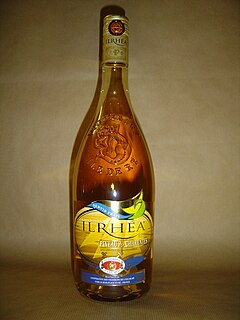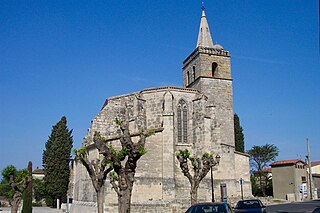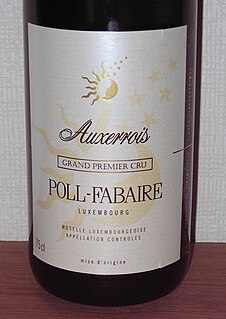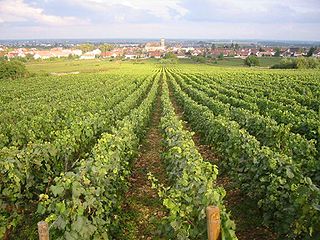
The Champagne wine region is a wine region within the historical province of Champagne in the northeast of France. The area is best known for the production of the sparkling white wine that bears the region's name. EU law and the laws of most countries reserve the term "Champagne" exclusively for wines that come from this region located about 160 kilometres (100 miles) east of Paris. The viticultural boundaries of Champagne are legally defined and split into five wine-producing districts within the historical province: Aube, Côte des Blancs, Côte de Sézanne, Montagne de Reims, and Vallée de la Marne. The towns of Reims and Épernay are the commercial centers of the area. Reims is famous for its cathedral, the venue of the coronation of the French Kings and a UNESCO World Heritage Site.

The Chablis region is the northernmost wine district of the Burgundy region in France. The cool climate of this region produces wines with more acidity and flavors less fruity than Chardonnay wines grown in warmer climates. These wines often have a "flinty" note, sometimes described as "goût de pierre à fusil", and sometimes as "steely". The Chablis Appellation d'origine contrôlée is required to use Chardonnay grapes solely.

Burgundy wine is wine made in the Burgundy region in eastern France, in the valleys and slopes west of the Saône, a tributary of the Rhône. The most famous wines produced here—those commonly referred to as "Burgundies"—are dry red wines made from pinot noir grapes and white wines made from chardonnay grapes.
A winemaker or vintner is a person engaged in winemaking. They are generally employed by wineries or wine companies, where their work includes:

Pineau des Charentes, is a regional aperitif of western France, made in the départements of Charente, Charente-Maritime, and Dordogne. While popular within its region of production, it is less well known in other regions of France and somewhat uncommon abroad.

French wine is produced all throughout France, in quantities between 50 and 60 million hectolitres per year, or 7–8 billion bottles. France is one of the largest wine producers in the world, along with Italian, Spanish, and American wine-producing regions. French wine traces its history to the 6th century BC, with many of France's regions dating their wine-making history to Roman times. The wines produced range from expensive wines sold internationally to modest wines usually only seen within France such as the Margnat wines were during the post war period.
The glossary of wine terms lists the definitions of many general terms used within the wine industry. For terms specific to viticulture, winemaking, grape varieties, and wine tasting, see the topic specific list in the "See also" section below.

The Confrérie des Chevaliers du Tastevin is an exclusive bacchanalian fraternity of Burgundy wine enthusiasts. It was founded in 1934. It is headquartered at the 12th century Château of Clos de Vougeot in the Côte d'Or region of France. It maintains chapters worldwide, called Sous-Commanderies, but because of its Gallic origins, its name and many of its ceremonial titles are always maintained in French.

Lebanon is among the oldest sites of wine production in the world. The Israelite prophet Hosea is said to have urged his followers to return to God so that "they will blossom as the vine and fame be like the wine of Lebanon, [and] their fragrance will be like that of Lebanon". The Phoenicians of the coastal strip were instrumental in spreading wine and viticulture throughout the Mediterranean in ancient times. Despite the many conflicts of the region, the country has an annual production of about 8,500,000 bottles of wine.

Argeliers is a commune in the Aude department in the Occitanie region of southern France.

Provence (Provençal) wine comes from the French wine-producing region of Provence in southeast France. The Romans called the area provincia nostra, giving the region its name. Just south of the Alps, it was the first Roman province outside Italy.

Nissan-lez-Enserune is a commune in the Hérault department in the Occitanie region in southern France, situated just south of Béziers. Its inhabitants are called the Nissanais.

Luxembourg wine is primarily produced in the southeastern part of the Grand Duchy of Luxembourg, with vineyards overlooking the Moselle River. Along this river, which for 42 km makes up part of the border between Luxembourg and Germany, wine is made in three countries. There is a continuous history of winemaking along Moselle and in Luxembourg going back to Ancient Roman times. Wine production in 2006/07 was 123,652 hectoliter from 1,237 hectares of vineyards. Out of total wine exports of 87,776 hectoliter in 2005/06, 71,726 hectoliter or 82% was exported to nearby Belgium. Exports to Germany were the second largest at 8,168 hectoliter, or 9%, and is to a large extent made up of base wine in bulk for the production of blended Sekt rather than being sold bottled with "Luxembourg" anywhere on the label. Therefore, very little Luxembourg wine is seen outside Luxembourg and Belgium.

Marsannay wine is produced in the communes of Marsannay-la-Côte, Couchey and Chenôve in the Côte de Nuits subregion of Burgundy. The Appellation d'origine contrôlée (AOC) Marsannay may be used for red and rosé wine with Pinot noir, as well as white wine with Chardonnay as the main grape variety. Red wine accounts for the largest part of the production, around two-thirds. Marsannay is the only village-level appellation which may produce rosé wines, under the designation Marsannay rosé. All other Burgundy rosés are restricted to the regional appellation Bourgogne. There are no Grand Cru or Premier Cru vineyards in Marsannay. The Marsannay AOC was created in 1987, and is the most recent addition to the Côte de Nuits.

Quebec wine is Canadian wine made in the province of Quebec. The grape varieties grown in Quebec, both white and red, all have common qualities needed by the harshness of the winter season, including resistance to winter temperatures, resistance to spring freezes and being early ripening. Some 40 varieties are grown in Quebec, with the most commonly planted being Maréchal Foch, Frontenac, De Chaunac, Vidal and Seyval blanc.

Duval-Leroy is a Champagne producer based in Vertus, a village in the Côte des Blancs region of Champagne. The house, founded in 1859, produces both vintage and non-vintage cuvées as well as a line of organic wines. The house of Duval-Leroy is also known for its pioneering role in promoting a sustainable development model for its viticulture.
Château Tournefeuille is a wine estate in Lalande-de-Pomerol, an appellation in Bordeaux near Pomerol and St. Emilion.
Domaine Armand Rousseau is a French wine grower and producer. It is based in Gevrey-Chambertin, in the Côte de Nuits wine-growing region of Burgundy, France.

Denis Dubourdieu was a French winemaker and professor of oenology at the University of Bordeaux. He managed or co-managed several properties in Bordeaux, including Château Reynon, Château Doisy Daëne, Château Cantegril, Château Haura, and Clos Floridène. He also consulted at Château Cheval Blanc.

The Revolt of the Languedoc winegrowers was a mass movement in 1907 in Languedoc and the Pyrénées-Orientales of France that was repressed by the government of Georges Clemenceau. It was caused by a serious crisis in winemaking at the start of the 20th century. The movement was also called the "paupers revolt" of the Midi. It was marked by the fraternization of the 17th line infantry regiment with the demonstrators in Béziers.

















